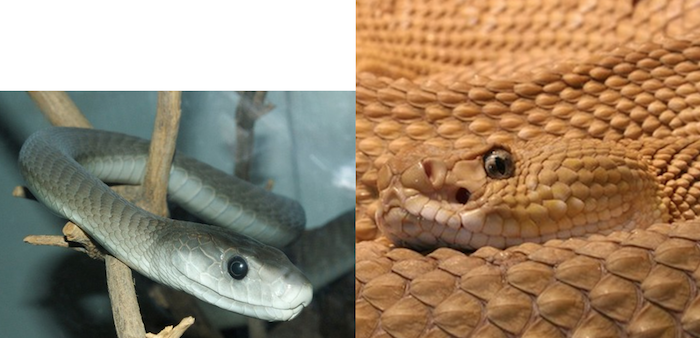 Be prepared. Know that anytime you are spending time in the outdoors you could encounter a snake. This is especially true during the warm summer months. If you are going camping or hiking, be prepared for snakes.[9]
Be prepared. Know that anytime you are spending time in the outdoors you could encounter a snake. This is especially true during the warm summer months. If you are going camping or hiking, be prepared for snakes.[9]
- Bring a first aid kit with you. If you are hiking or camping, you should have basic supplies.
- Your kit should include compression bandages, antibiotic ointment, and gauze. You should also pack a pamphlet with first aid guidelines.[10]
- Take plenty of bottle water with you. You can use it to hydrate a snake bite victim, and clean wounds.
- Carry a cell phone. You will need it to call for help if you or a companion is bitten by any snake.
3
Identifying Dangerous Snakes
 Observe the snake’s posture. Not all snakes are dangerous. However, it is a good rule of thumb to avoid any snakes you encounter in the wild. Certain signals can tell you whether the snake in question is particularly dangerous.[11]
Observe the snake’s posture. Not all snakes are dangerous. However, it is a good rule of thumb to avoid any snakes you encounter in the wild. Certain signals can tell you whether the snake in question is particularly dangerous.[11]
- Pay attention to the snake’s position. A coiled snake is likely getting ready to strike.
- If you encounter a rattle snake, back away slowly. If the snake is coiled and audibly rattling, it is getting ready to strike.
- Be aware that a snake can strike from any position. It can strike the furthest distance from a coiled position, but it can also attack from a stretched out position.
 Recognize poisonous snakes. There is no full proof way to tell if the snake you encounter is venomous. It’s a good idea to assume that it is, and move along. Venomous snakes do carry some common traits that are good indicators that they are poisonous.[12]
Recognize poisonous snakes. There is no full proof way to tell if the snake you encounter is venomous. It’s a good idea to assume that it is, and move along. Venomous snakes do carry some common traits that are good indicators that they are poisonous.[12]
 Be prepared. Know that anytime you are spending time in the outdoors you could encounter a snake. This is especially true during the warm summer months. If you are going camping or hiking, be prepared for snakes.[9]
Be prepared. Know that anytime you are spending time in the outdoors you could encounter a snake. This is especially true during the warm summer months. If you are going camping or hiking, be prepared for snakes.[9]
- Bring a first aid kit with you. If you are hiking or camping, you should have basic supplies.
- Your kit should include compression bandages, antibiotic ointment, and gauze. You should also pack a pamphlet with first aid guidelines.[10]
- Take plenty of bottle water with you. You can use it to hydrate a snake bite victim, and clean wounds.
- Carry a cell phone. You will need it to call for help if you or a companion is bitten by any snake.
3
Identifying Dangerous Snakes
 Observe the snake’s posture. Not all snakes are dangerous. However, it is a good rule of thumb to avoid any snakes you encounter in the wild. Certain signals can tell you whether the snake in question is particularly dangerous.[11]
Observe the snake’s posture. Not all snakes are dangerous. However, it is a good rule of thumb to avoid any snakes you encounter in the wild. Certain signals can tell you whether the snake in question is particularly dangerous.[11]
- Pay attention to the snake’s position. A coiled snake is likely getting ready to strike.
- If you encounter a rattle snake, back away slowly. If the snake is coiled and audibly rattling, it is getting ready to strike.
- Be aware that a snake can strike from any position. It can strike the furthest distance from a coiled position, but it can also attack from a stretched out position.
 Recognize poisonous snakes. There is no full proof way to tell if the snake you encounter is venomous. It’s a good idea to assume that it is, and move along. Venomous snakes do carry some common traits that are good indicators that they are poisonous.[12]
Recognize poisonous snakes. There is no full proof way to tell if the snake you encounter is venomous. It’s a good idea to assume that it is, and move along. Venomous snakes do carry some common traits that are good indicators that they are poisonous.[12]
Page 3 of 4





































Discussion about this post